Building Health Skills: Interpersonal Communication
By Suzanne Schrag
HealthSmart Series Editor
If you’re an educator, you know that children and youth communicate all the time. Most classrooms and school grounds present an absolute flurry of communication.
It’s no wonder the National Health Education Standards expressly include interpersonal communication as an essential element of effective health education.
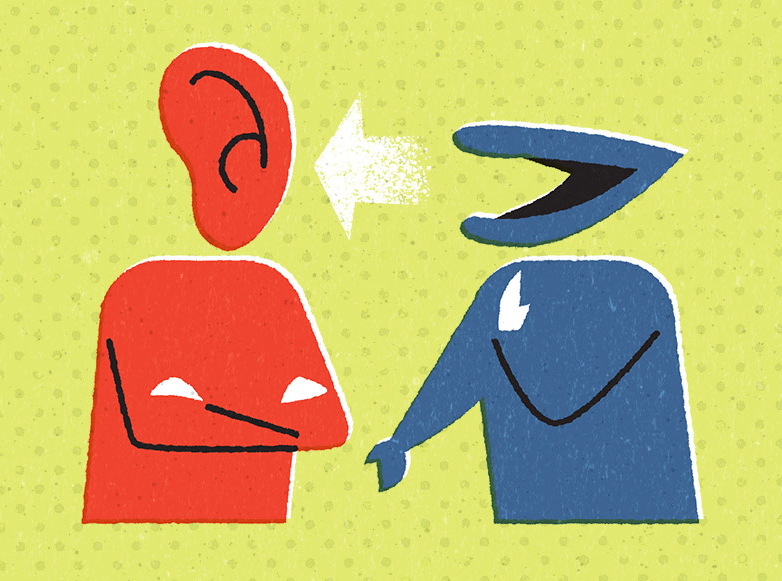 This is because communicating about health, and knowing how to communicate in ways that build relationships, are distinctive skills that take practice to master. According to the Standards, “Effective communication enhances personal, family and community health…. The ability to organize and to convey information and feelings is the basis for strengthening interpersonal interactions and reducing or avoiding conflict.”
This is because communicating about health, and knowing how to communicate in ways that build relationships, are distinctive skills that take practice to master. According to the Standards, “Effective communication enhances personal, family and community health…. The ability to organize and to convey information and feelings is the basis for strengthening interpersonal interactions and reducing or avoiding conflict.”
Communicating for Health
From expressing emotions, to effectively resisting pressure and respecting others’ limits, to resolving conflicts and knowing how and when to ask for help, communication is a skill that runs through all of the health content areas at each grade level in ETR’s HealthSmart program. Good communication is one of the foundations of healthy relationships, as well as the way young people can express their needs, advocate for themselves and get support for healthy choices.
This health skill is covered by Standard 4, and, although the language used in the performance indicators becomes more detailed and complex as you move up the grade spans, the key aspects of this skill remain remarkably similar across grades K through 12. Expressing oneself in effective and healthy ways; being able to refuse unwanted behaviors, resist pressure and negotiate; understanding and demonstrating skills to manage or resolve conflict; and effectively asking for assistance when needed are all emphasized at each grade level.
Some HealthSmart Examples
Expressing Feelings, Needs and Wants
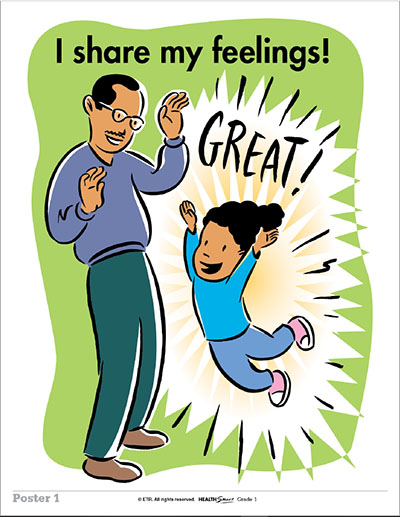 Recognizing and expressing emotions, particularly those that may be troublesome in some way such as anger, sadness or fear, is explored in lessons relating to emotional health at Grades K through 2. Lessons help students identify different feelings, explain the relationship between feelings and behavior, and practice self-control and other strategies for coping with strong emotions.
Recognizing and expressing emotions, particularly those that may be troublesome in some way such as anger, sadness or fear, is explored in lessons relating to emotional health at Grades K through 2. Lessons help students identify different feelings, explain the relationship between feelings and behavior, and practice self-control and other strategies for coping with strong emotions.
At the upper elementary grades (Grades 3–5), these themes continue, with an added emphasis on understanding both verbal and nonverbal communication, being sensitive to the feelings of others, and identifying elements of effective and respectful communication. Middle and High School students continue to identify and explore communication, including effective listening skills, ways to express empathy and condolence, and use of I-messages.
Refusal and Negotiation Skills
At the K–2 grade level, the standards want students to “demonstrate ways to respond in an unwanted, threatening or dangerous situation.” Saying no and getting away, if possible, when confronted with unwanted/unsafe touch or other threats to safety is the main lesson students practice.
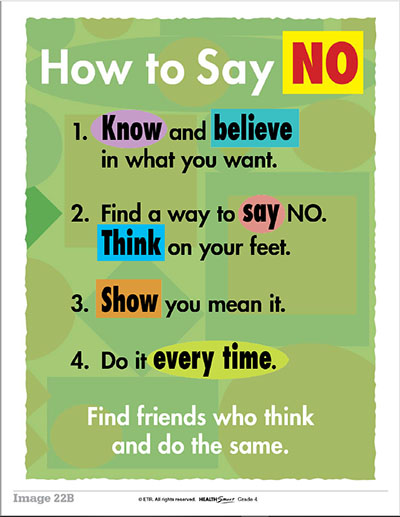 By Grades 3–5, this performance indicator refers to demonstrating “refusal skills that avoid or reduce health risks,” and lessons offer a more nuanced approach, helping students anticipate pressures and practice how to resist them with effective refusals, particularly in the areas of substance use and risky dares.
By Grades 3–5, this performance indicator refers to demonstrating “refusal skills that avoid or reduce health risks,” and lessons offer a more nuanced approach, helping students anticipate pressures and practice how to resist them with effective refusals, particularly in the areas of substance use and risky dares.
A simple process for making an effective refusal is introduced in Grade 3, with an emphasis on the importance of using the word “no,” reinforcing a refusal with appropriate body language, and repeating the refusal if needed. Grade 4 adds the idea of thinking on your feet, and leaving the situation if necessary, while Grade 5 introduces suggesting alternative actions as a further refusal technique.
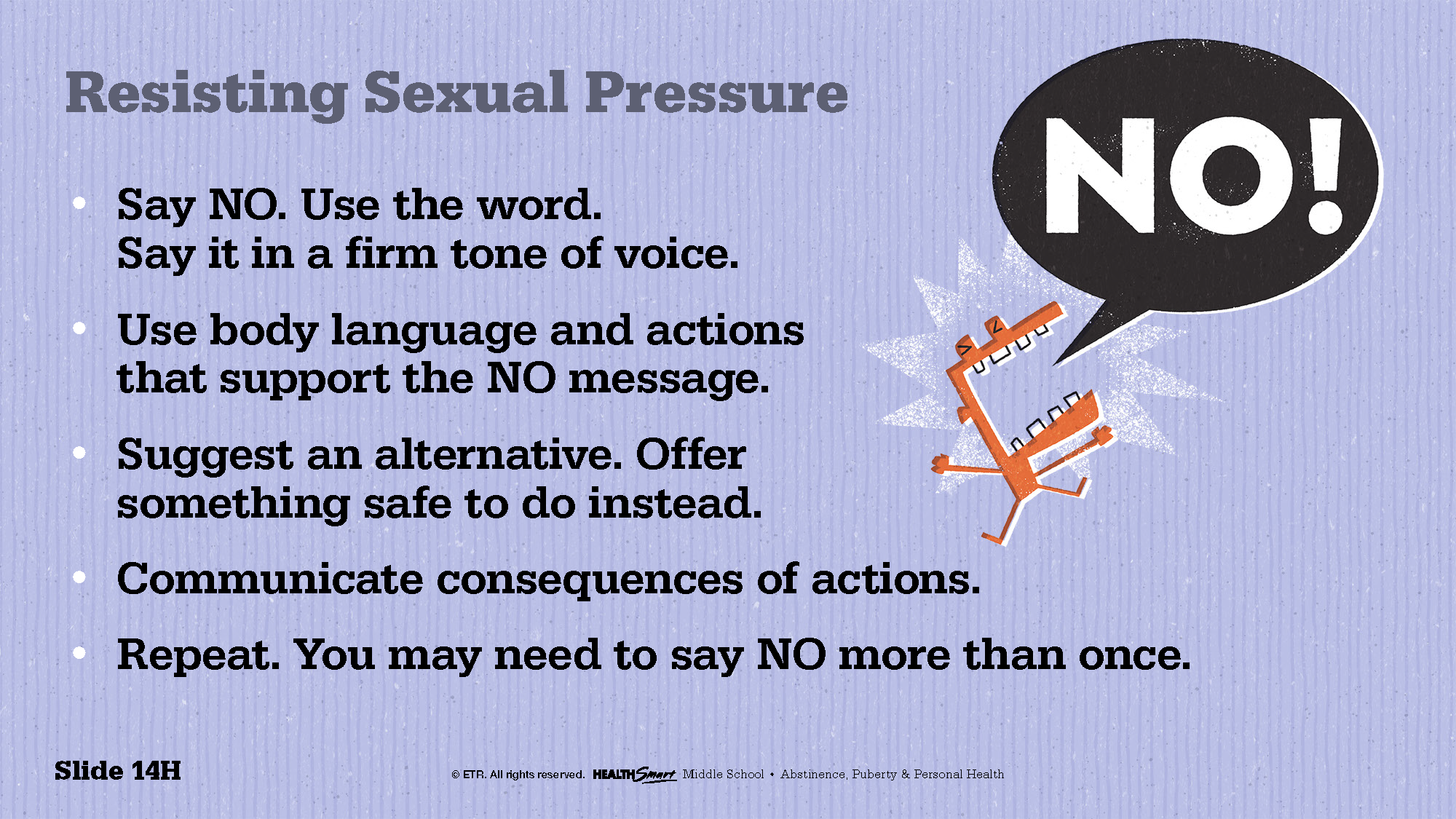 Roleplay practice is a key learning strategy in the Middle and High School lessons that emphasize refusal and/or negotiation skills. The process for resisting pressure continues to emphasize thinking and speaking clearly, using and repeating the word “no” with matching body language, and suggesting alternatives, as in this example from the HIV, STD & Pregnancy Prevention lesson on saying no to sexual pressure:
Roleplay practice is a key learning strategy in the Middle and High School lessons that emphasize refusal and/or negotiation skills. The process for resisting pressure continues to emphasize thinking and speaking clearly, using and repeating the word “no” with matching body language, and suggesting alternatives, as in this example from the HIV, STD & Pregnancy Prevention lesson on saying no to sexual pressure:
- Say the word NO.
- Use actions and body language that reinforce the NO.
- Repeat the NO message if you need to.
- Say NO when you need to.
- Suggest an alternative, if this is someone you want to still have a relationship with.
- Be sure your words and actions are real for the situation and would work with the people you know.
The same steps are used in lessons on resisting peer pressure to eat unhealthy foods, take unsafe risks, or use tobacco, alcohol or other drugs. High School uses a similar process, but emphasizes three refusal strategies: (1) a clear NO statement, which includes verbal and nonverbal messages and repetition when needed; (2) suggesting alternative actions to get out of the situation and keep a relationship going; and (3) delay tactics, which can break the mood or cool down the situation and give the person being pressured time to think, and include leaving if the pressure continues.
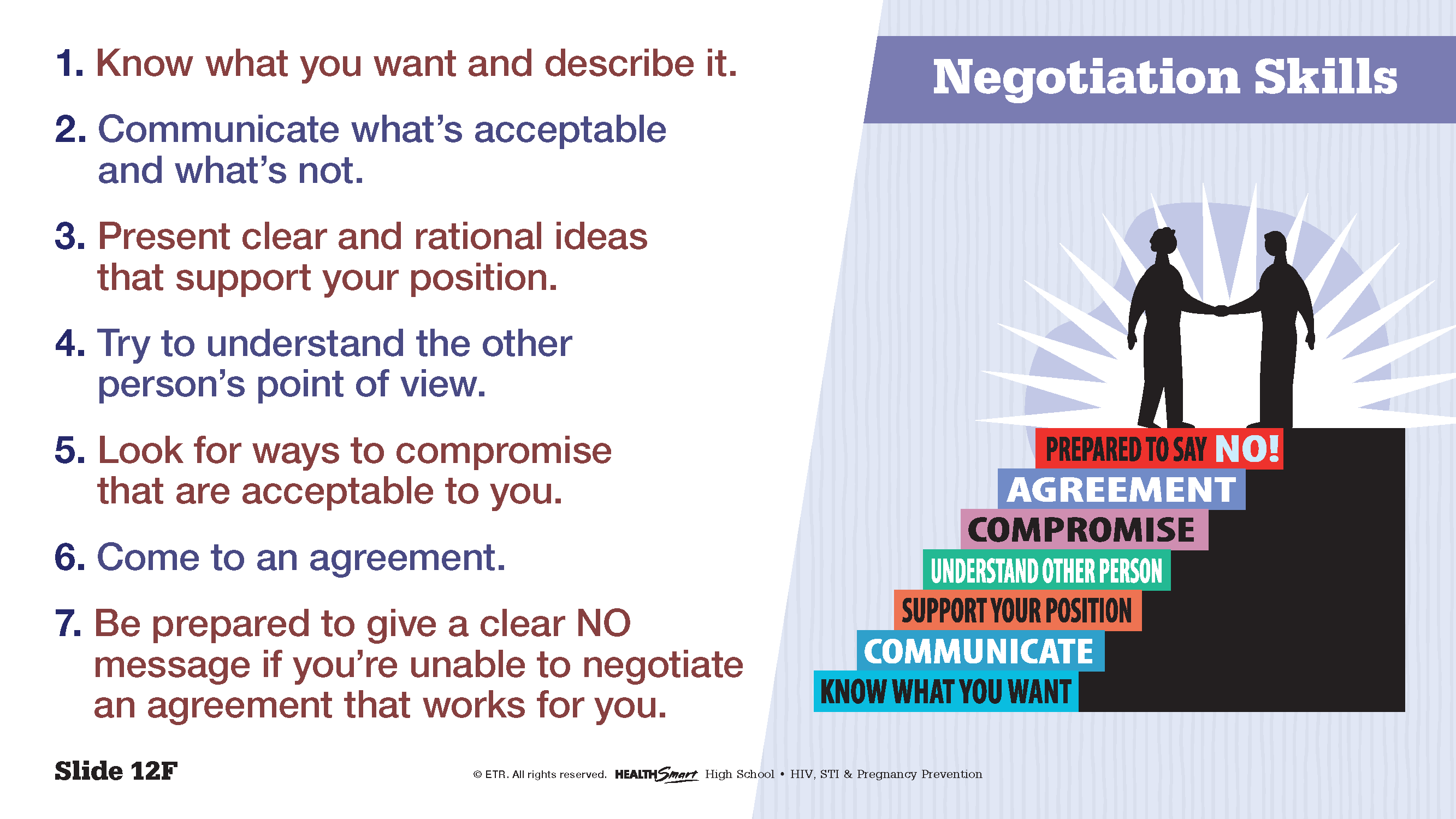 High School also emphasizes techniques for successful negotiation:
High School also emphasizes techniques for successful negotiation:
- Know what you want and describe it.
- Communicate what’s acceptable and what’s not.
- Present clear and rational ideas that support your position.
- Try to understand the other person’s point of view.
- Look for ways to compromise that are acceptable to you.
- Come to an agreement.
- Be prepared to give a clear NO message if you’re unable to negotiate an agreement that’s acceptable to you.
A Note on Refusals Skills and Consent
When teaching refusal and negotiation skills, particularly around sexual pressures, it is important to affirm the value that no person deserves to be pressured or forced to do something unwanted and no person who experiences pressure, harassment or assault is to blame for being the target of those behaviors. Clear, assertive refusal and negotiation skills can be encouraged, while also making sure youth understand that only an affirmative “yes” can mean consent to having sex or other behaviors and to continuing those activities. A conversation on personal boundaries and respecting another person’s decision can help optimize the success of the skill-building around refusal and negotiation.
Resolving Conflict
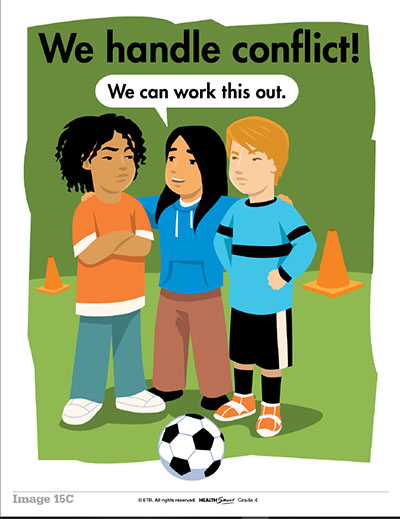 Skills for managing and resolving conflict are first addressed in the Standard 4 performance indicators at the Grade 3–5 span. Students learn how to distinguish between simple conflict that they can handle among themselves and more serious conflict that requires adult help. They can then practice applying some basic strategies for handling conflict:
Skills for managing and resolving conflict are first addressed in the Standard 4 performance indicators at the Grade 3–5 span. Students learn how to distinguish between simple conflict that they can handle among themselves and more serious conflict that requires adult help. They can then practice applying some basic strategies for handling conflict:
- Talk it out.
- Try to see the other side.
- Say you’re sorry (if applicable).
- Suggest ways to solve the problem.
- Be flexible and compromise.
- Get help, if needed.
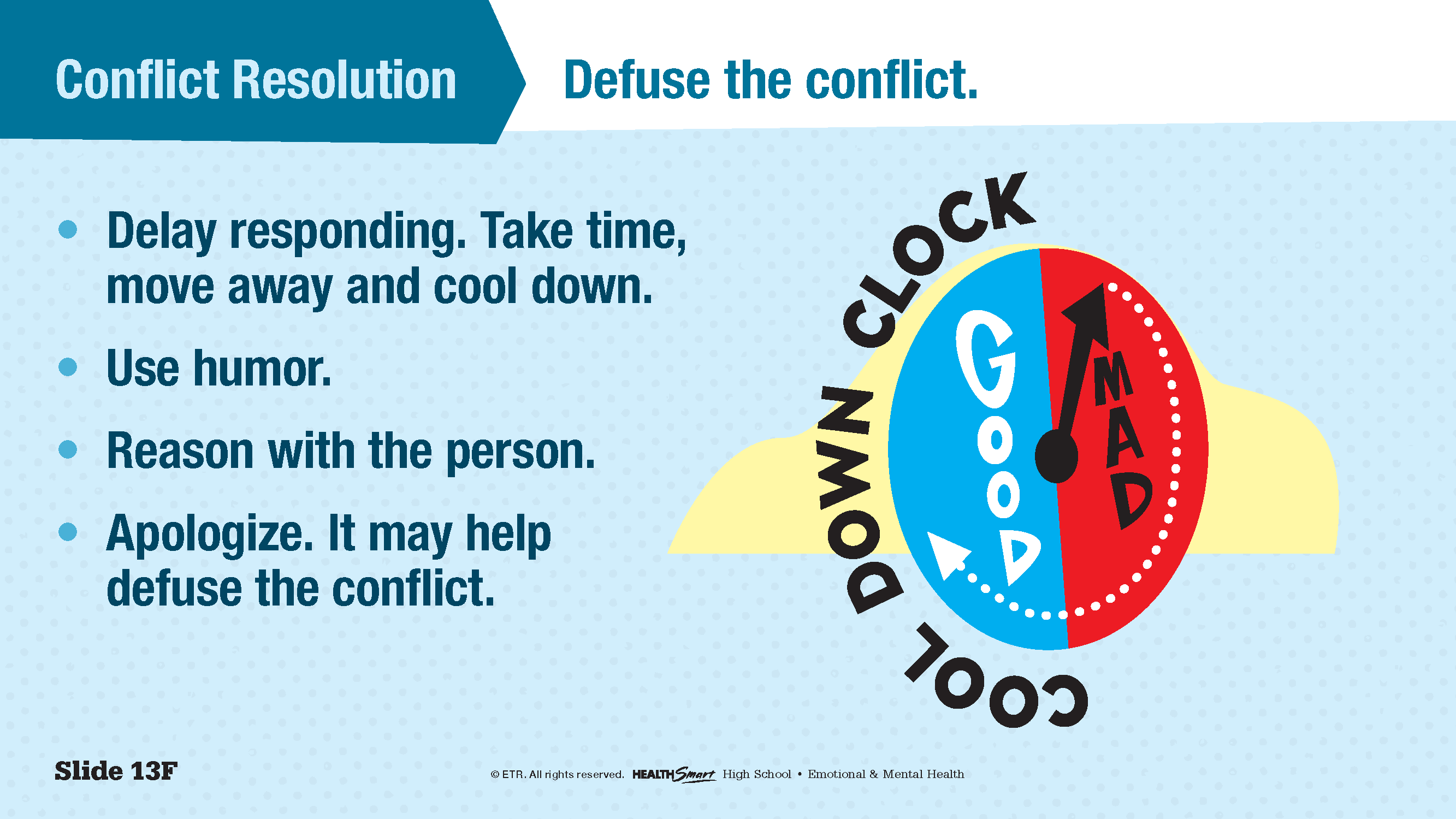 Middle School and High School lessons further develop skills for conflict negotiation and resolution, with a series of different strategies that can be applied to many types of situations:
Middle School and High School lessons further develop skills for conflict negotiation and resolution, with a series of different strategies that can be applied to many types of situations:
- Avoid the conflict (by keeping away from triggers or walking away when conflict happens).
- Defuse the conflict (by using delay, humor, reasoning or apologizing, if appropriate).
- Negotiate (by talking out the problem, seeing the other person’s side, suggesting solutions and agreeing on a solution to try).
- Get help (which involves recognizing when a conflict is becoming dangerous, knowing whom to ask for help and acting quickly when necessary).
Getting Help
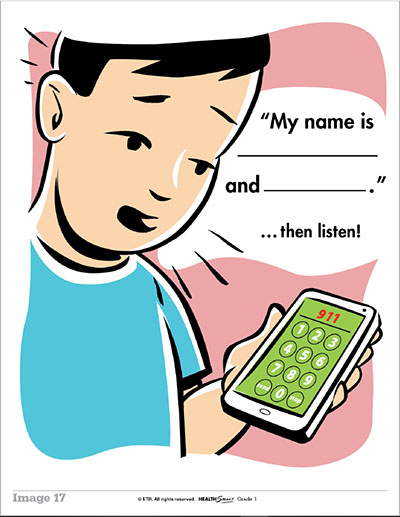 Along with knowing how to access resources (Standard 3), being able to clearly communicate requests for assistance helps ensure young people can get the support and help they need to stay safe and healthy. This is the fourth performance indicator for the skill of communication at all grade spans. For students in Grades K through 2, the goal is to be able to demonstrate ways to tell an adult if threatened or harmed. Lessons at these grade levels cover how to clearly request help in an emergency, including calling 9-1-1, report bullying and unsafe/unwanted touch, and identify trusted adults who can provide support and assistance. Grades 3 through 5 also cover reporting bullying and inappropriate touch, as well as asking for help with troublesome feelings, serious conflicts, family substance use issues and questions/concerns about puberty.
Along with knowing how to access resources (Standard 3), being able to clearly communicate requests for assistance helps ensure young people can get the support and help they need to stay safe and healthy. This is the fourth performance indicator for the skill of communication at all grade spans. For students in Grades K through 2, the goal is to be able to demonstrate ways to tell an adult if threatened or harmed. Lessons at these grade levels cover how to clearly request help in an emergency, including calling 9-1-1, report bullying and unsafe/unwanted touch, and identify trusted adults who can provide support and assistance. Grades 3 through 5 also cover reporting bullying and inappropriate touch, as well as asking for help with troublesome feelings, serious conflicts, family substance use issues and questions/concerns about puberty.
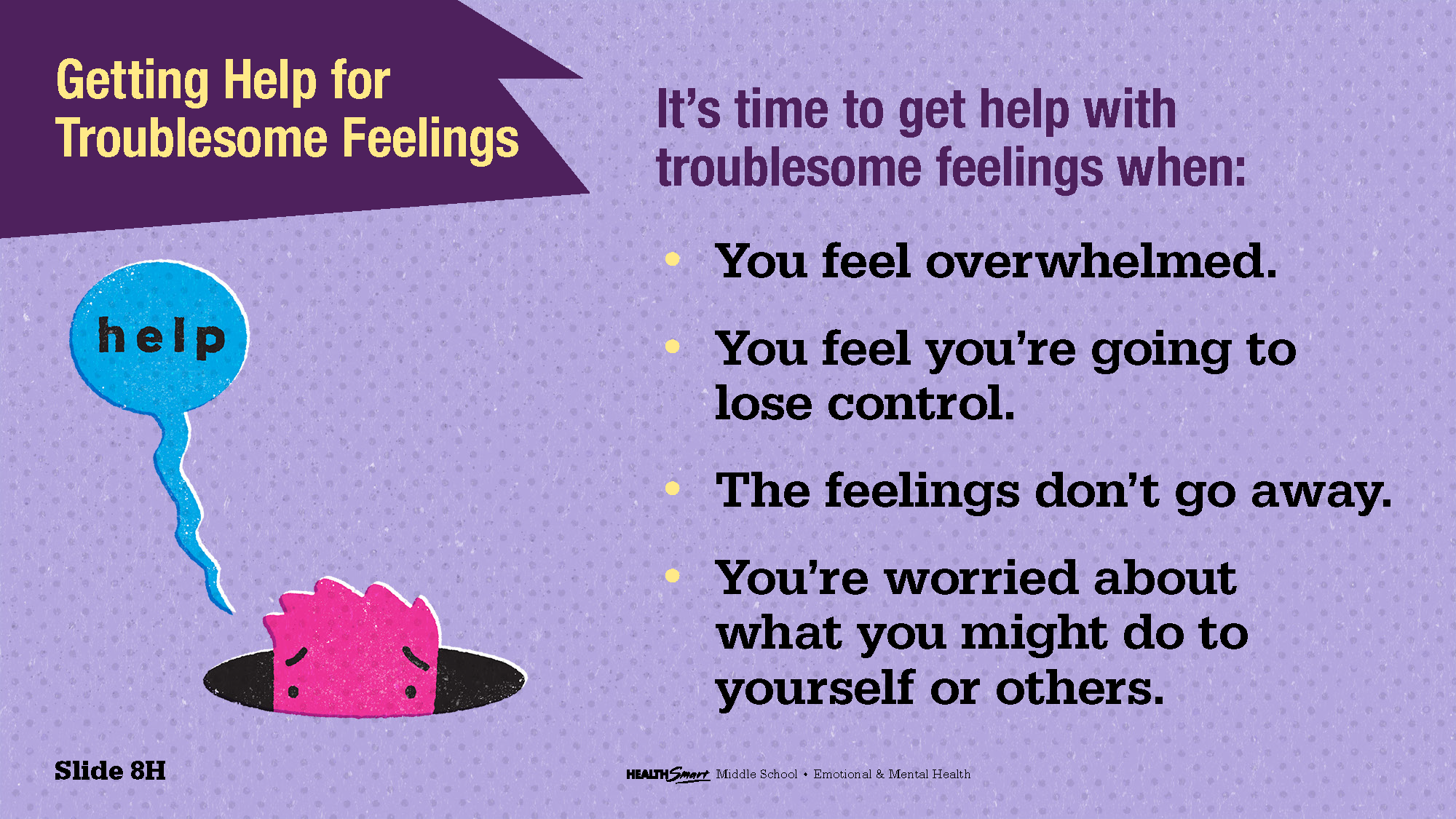 At the Middle and High School levels, asking for assistance is extended to seeking help for others as well as self. In the Emotional & Mental Health unit, students learn warning signs that troublesome feelings require help and demonstrate how to effectively ask for help for themselves or a friend who may be experiencing mental health issues, including eating disorders. This performance indicator is also met by conflict resolution lessons, which help students recognize when a conflict could escalate and become dangerous and practice how to ask for help from an adult, and in lessons around bullying, including cyberbullying, and suicide prevention.
At the Middle and High School levels, asking for assistance is extended to seeking help for others as well as self. In the Emotional & Mental Health unit, students learn warning signs that troublesome feelings require help and demonstrate how to effectively ask for help for themselves or a friend who may be experiencing mental health issues, including eating disorders. This performance indicator is also met by conflict resolution lessons, which help students recognize when a conflict could escalate and become dangerous and practice how to ask for help from an adult, and in lessons around bullying, including cyberbullying, and suicide prevention.


